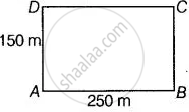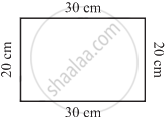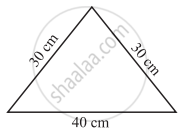Advertisements
Advertisements
प्रश्न
Length of a rectangular field is 250 m and width is 150 m. Anuradha runs around this field 3 times. How far did she run? How many times she should run around the field to cover a distance of 4 km?
उत्तर
Given, length of rectangular field `(l)` = 250 m
And width of rectangular field `(b)` = 150 m
Perimeter of the field = `2(l + b)` = 2(250 + 150) m = `2 xx 400` m = 800 m
∵ Distance covered in one round = Perimeter = 800 m
∴ Distance covered in three rounds = `3 xx 800` = 2400 m
Now, number of rounds to cover 4 km, i.e. 4000 m = `4000/800` = 5 .....[∵ 1 km = 1000 m]
Hence, she should run 5 times around the field around the field to cover the distance of 4 km.
APPEARS IN
संबंधित प्रश्न
The perimeter of a rectangle is 46 m and its length is 15 m. Find its :
(i) breadth
(ii) area
(iii) diagonal.
The diagonal of a rectangle is 34 cm. If its breadth is 16 cm; find its :
(i) length
(ii) area
Find the perimeter of an equilateral triangle of side 9.8 cm.
Each side of a square is 45 cm and a rectangle has length 50 cm. If the perimeters of both (square and rectangle) are same, find the breadth of the rectangle.
Find the cost of fencing a rectangular park of length 250 m and breadth 175 m at the rate of Rs. 12 per metre.
A game requires its players to run around a square playground. Each side of the playground is 20 m long. One player took 5 rounds around the playground. How many metres did he run altogether?
Look at the figures on the sheet of graph paper. Measure their sides with the help of the lines on the graph paper. Write the perimeter of each in the right box.

- Perimeter of rectangle ABCD = ______ cm.
- Perimeter of rectangle EFGH = ______ cm.
- Perimeter of square PQRS = ______ cm.
- Perimeter of rectangle STUV = ______ cm.
How many different rectangles can be made with a 48 cm long string? Find the possible pairs of length and breadth of the rectangles.
Find the cost of fencing a rectangular park of length 175 m and breadth of 125 m at the rate of ₹ 12 per metre.
What is the perimeter of the following figures? What do you infer from the answers?
 (a) |
 (c) |
 (b) |
 (d) |
